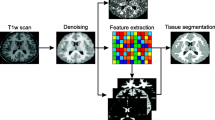Abstract
In this paper, we present non-identical unsupervised clustering techniques for the segmentation of CT brain images. Prior to segmentation, we enhance the visualization of the original image. Generally, for the presence of abnormal regions in the brain images, we partition them into 3 segments, which are the abnormal regions itself, the cerebrospinal fluid (CSF) and the brain matter. However, for the absence of abnormal regions in the brain images, the final segmented regions will consist of CSF and brain matter only. Therefore, our system is divided into two stages of clustering. The initial clustering technique is for the detection of the abnormal regions. The later clustering technique is for the segmentation of the CSF and brain matter. The system has been tested with a number of real CT head images and has achieved satisfactory results.
Similar content being viewed by others
References
A. Dempster, N. Laird, and D. Rubin, “Maximum Likelihood from Incomplete Data via the EM Algorithm”, J. Royal Statistical Soc., vol. 39, 1977, pp. 1–38.
Albert Huang, Rafeef Abugharbieh, Roger Tam, Anthony Traboulsee, “MRI Brain Extraction with Combined Expectation Maximization and Geodesic Active Contours”, Signal Processing and Information Technology, 2006 IEEE International Symposium, Aug. 2006, pp.107–111.
Dubravko Cosic, Sven Loncaric, “Rule-Based Labeling of CT Head Image”, 6th Conference on Artificial Intelligence in Medicine, 1997, pp. 453–456
K.H. Hohne and W.A. Hanson, “Interactive 3D segmentation of MRI and CT volumes using morphological operations”, J. Comp. Assist. Tomogr. 2, 1992, pp. 285–294.
Lemieux L., Hagemann G., Krakow K., Woermann F.G., “Fast, accurate, and reproducible automatic segmentation of the brain in T1-weighted volume MRI data”, Magnetic Resonance in Medicine 42, 1999, pp.127–135.
MATESIN Milan, LONCARIC Sven, PETRAVIC Damir, “A rule-based approach to stroke lesion analysis from CT brain images”, 2nd international symposium on image and signal processing and analysis, June 2001, pp. 219–223
N. A. Mohamed, M. N. Ahmed, and A. Farag, “Modified Fuzzy C-Mean in Medical Image Segmentation”, Acoustics, Speech, and Signal Proceedings, vol.6, 1999, pp. 3429–3432.
Nathalie Richarda, Michel Dojata, Catherine Garbayvol, “Distributed Markovian segmentation: Application to MR brain scans”, Journal of Pattern Recognition 40, 2007, pp. 3467–3480.
Qingmao Hu, Guoyu Qian, Aamer Aziz, Wieslaw L. Nowinsk, “Segmentation of brain from computed tomography head images”, Proceedings of IEEE Engineering in Medicine and Biology 27th Annual conference, Sept. 2005, pp. 3375 – 3378.
Ruzica Maksimovic, Srdjan Stankovic and Dragorad Milovanovic, “Computed tomography image analyzer: 3D reconstruction and segmentation applying active contour models snakes”, International Journal of Medical Informatics Volumes 58–59, Sept. 2000, pp. 29–37.
Tong Hau Lee, Mohammad Faizal Ahmad Fauzi and Ryoichi Komiya, “Segmentation of CT Head Images”, Conference on Biomedical Engineering and Informatics, 2008.
Wei Kaiping, He Bin, Zhang Tao, Shen Xianjun, “A Novel Method for Segmentation of CT Head Images”, International Conference on Bioinformatics and Biomedical Engineering, July 2007, pp. 717–720.
Y. Zhang, M. Brady, S. Smith, “Segmentation of brain MR images through a hidden Markov random field model and the expectation-maximization algorithm”, IEEE Transactions Medical Imaging, vol. 20, Jan. 2001, pp. 45–57.
Author information
Authors and Affiliations
Corresponding author
Additional information
Tong Hau Lee: He received his M.Sc. (IT) in 2001 from University Sains Malaysia. He works in Multimedia University as a lecturer since 2001. His research interest is in digital image processing such as image segmentation and semantics-based image retrieval.
Mohammad Faizal Ahmad Fauzi: He received the B.Eng. degree in electrical and electronic engineering from Imperial College, London, UK in 1999, and the Ph.D. degree in electronics and computer science from University of Southampton, Southampton, UK in 2004. He is currently attached to the Multimedia University, Malaysia as a lecturer/researcher. His main research interests are in the area of signal processing, analysis, retrieval and compression of image, audio and video data, as well as biometrics.
Ryoichi Komiya: He received the B.E. and Ph.D. degrees from Waseda University, Tokyo, Japan, in 1967 and 1986, respectively. Since 1998, he has been at Multimedia University Malaysia, where he has been responsible for research and development of next generation telecommunication systems, services, terminals, IP network, virtual education environment, e-commerce terminal and Intelligent Transportation System. From 2006 to 2008, he was at National Institute of Information and Communication Technology, Japan where he has been promoting R&D on medical ICT. He is currently a visiting professor at Faculty of Software and Information of Iwate Prefectural University, Japan.
Rights and permissions
About this article
Cite this article
Lee, T.H., Fauzi, M.F.A. & Komiya, R. Segmentation of CT brain images using unsupervised clusterings. J Vis 12, 131–138 (2009). https://doi.org/10.1007/BF03181955
Received:
Revised:
Issue Date:
DOI: https://doi.org/10.1007/BF03181955




